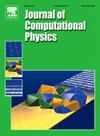具有几何界面重建的尖锐前端跟踪
IF 3.8
2区 物理与天体物理
Q2 COMPUTER SCIENCE, INTERDISCIPLINARY APPLICATIONS
引用次数: 0
摘要
本文提出了一种新颖的尖锐前沿跟踪方法,旨在解决经典前沿跟踪方法的局限性,特别是它们依赖于光滑插值核和扩展模板来耦合前沿和流体网格。相比之下,该方法只采用尖锐的局部插值和扩散核,将耦合限制在包含界面/前沿的界面流体细胞上。这种局部耦合是通过将保持散度的速度插值方法与分段抛物界面计算(PPIC)和多面体相交算法相结合来计算指示函数和局部界面曲率来实现的。使用连续表面力(CSF)方法计算表面张力,保持与尖锐表示的一致性。此外,我们提出了一个有效的局部粗糙度平滑实现,以考虑表面网格波动,这很容易适用于任何三角表面网格。在我们之前工作的基础上,本研究的主要创新在于指示器函数和表面张力计算耦合的本地化。通过将流体网格上的界面厚度减小到单个单元,而不是传统方法中典型的4-5个单元跨度,所提出的尖锐前沿跟踪方法实现了界面的高度局部化和精确表示。这种更清晰的表示减轻了寄生电流并改善了力平衡,使其特别适用于界面起关键作用的场景,例如微流体、流体-流体相互作用和流体-结构相互作用。该方法在典型界面流动问题上得到了全面的验证和测试,包括稳态和平移拉普拉斯平衡、振荡液滴和上升气泡。结果表明,尖锐前跟踪方法在精度、稳定性和计算效率方面明显优于经典方法。值得注意的是,寄生电流减少了大约两个数量级,并且在经典前沿跟踪无法收敛的参数范围内获得了稳定的结果。本文章由计算机程序翻译,如有差异,请以英文原文为准。
Sharp front tracking with geometric interface reconstruction
This paper presents a novel sharp front-tracking method designed to address limitations in classical front-tracking approaches, specifically their reliance on smooth interpolation kernels and extended stencils for coupling the front and fluid mesh. In contrast, the proposed method employs exclusively sharp, localized interpolation and spreading kernels, restricting the coupling to the interfacial fluid cells–those containing the interface/front. This localized coupling is achieved by integrating a divergence-preserving velocity interpolation method with a piecewise parabolic interface calculation (PPIC) and a polyhedron intersection algorithm to compute the indicator function and local interface curvature. Surface tension is computed using the Continuum Surface Force (CSF) method, maintaining consistency with the sharp representation. Additionally, we propose an efficient local roughness smoothing implementation to account for surface mesh undulations, which is easily applicable to any triangulated surface mesh. Building on our previous work, the primary innovation of this study lies in the localization of the coupling for both the indicator function and surface tension calculations. By reducing the interface thickness on the fluid mesh to a single cell, as opposed to the 4–5 cell spans typical in classical methods, the proposed sharp front-tracking method achieves a highly localized and accurate representation of the interface. This sharper representation mitigates parasitic currents and improves force balancing, making it particularly suitable for scenarios where the interface plays a critical role, such as microfluidics, fluid-fluid interactions, and fluid-structure interactions. The proposed method is comprehensively validated and tested on canonical interfacial flow problems, including stationary and translating Laplace equilibria, oscillating droplets, and rising bubbles. The presented results demonstrate that the sharp front-tracking method significantly outperforms the classical approach in terms of accuracy, stability, and computational efficiency. Notably, parasitic currents are reduced by approximately two orders of magnitude and stable results are obtained for parameter ranges where classical front tracking fails to converge.
求助全文
通过发布文献求助,成功后即可免费获取论文全文。
去求助
来源期刊

Journal of Computational Physics
物理-计算机:跨学科应用
CiteScore
7.60
自引率
14.60%
发文量
763
审稿时长
5.8 months
期刊介绍:
Journal of Computational Physics thoroughly treats the computational aspects of physical problems, presenting techniques for the numerical solution of mathematical equations arising in all areas of physics. The journal seeks to emphasize methods that cross disciplinary boundaries.
The Journal of Computational Physics also publishes short notes of 4 pages or less (including figures, tables, and references but excluding title pages). Letters to the Editor commenting on articles already published in this Journal will also be considered. Neither notes nor letters should have an abstract.
 求助内容:
求助内容: 应助结果提醒方式:
应助结果提醒方式:


